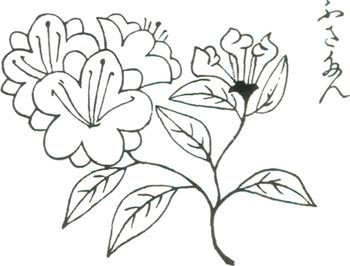JARS v39n1 - Book Review: 'A Brocade Pillow'
Book Review: "A Brocade Pillow"
Helga Andrews
Sudbury, Massachusetts
Reprinted from Massachusetts Chapter "Rosebay"
Although it may sound like the title of a passionate historical romance, A Brocade Pillow is actually a late-17th century monograph on azaleas by a Japanese nurseryman, Ito Ihei, fortunately translated into English, by Kaname Kato and John L. Creech. It is in fact the introduction and notes by Dr. Creech that help to steer the American reader through the descriptions of the amazing variety of azaleas cultivated by the Japanese at that time, most of which we are just beginning to introduce into our own gardens. And for those of us in the Northeast, it is only as breeders work for increased hardiness that we can begin to appreciate the size and beauty of these azaleas at home.
As Dr. Creech says in his introduction, "Ito's purpose was to provide an illustrated description of the azaleas in cultivation and to correct some of the confusion caused by name duplication. Of the 332 azaleas he described, 171 belong to the tsutsuji group and 161 to the satsuki group, encompassing fifteen species, as best we can reckon from these early Japanese descriptions, of course."
After an introduction in which he establishes classifications according to flowering season, size of flowers and flower patterns, Ito divides his work into 5 volumes, 3 describing tsutsuji azaleas and 2 the satsuki azaleas, closing with a few notes on culture. Dr. Creech points out that the tsutsuji, the Japanese word for azalea, are more familiar to American gardeners because of their early flowering, brilliant colors and ease of cultivation, and includes two main groups, those derived from R. kaempferi , R. kiusianum and R. sataense , as in the Kurume azaleas, and those based on R. macrosepalum , R. x Mucronatum and R. scabrum . The tsutsuji volumes include all the species then grown in Japan except R. indicum , considered one of the parents of the satsuki azaleas. Dr. Creech considers the satsuki azaleas "Japan's most precious gardening offer to the West." Satsuki actually means "fifth month," corresponding to our June, when most of the satsuki flower, one month later than the May-flowering tsutsuji. The typical satsuki have heavy, evergreen foliage, often turning purple in winter, and large, thick-textured flowers. The Japanese value them as show flowers, with some bonsai plants said to be over 400 years old, and consider their habit of sporting a virtue, unlike those Western nurserymen who prefer consistency in their plants. Although most of the satsuki are grown as pot plants, Dr. Creech tempts one by mentioning landscape selections now being grown at the National Arboretum and by providing a photograph of the sheared plants used as hedging in Japan, extraordinary rounded mounds undulating along a path.
Dr. Creech's commentary throughout the book helps to orient and educate the Western reader. Here is a characteristic one on a plant called Black Ship by Ito, whose description states: "The very large cherry-blossom pink flowers bloom in dense clusters like the true rhododendron. The large leaves are similar to the daimyo oak and arranged in a wheel, as the illustration shows. Some people use these branches for the body of flower arrangements, and they are considered very elegant for this purpose." To which Dr. Creech adds the comment, "This is R. schlippenbachii , the Royal azalea from Korea. It was brought to Japan at an extremely early date and may have actually arrived from China since it is also called 'Kara no tsutsuji' (Chinese azalea). It is interesting to note that while its discovery in the wild by Westerners did not occur until 1854, R. schlippenbachii was known to the Japanese as a cultivated plant before the writing of A Brocade Pillow . The daimyo oak is Quercus dentata ." Elsewhere he mentions that the name Black Ship probably refers to the Chinese ship by which it was introduced to Japan.
There are helpful lists, one including literal translations of the Japanese azalea names: evocative names like Morning Mist, Scalloped Waves, and Snow on Bamboo, descriptive ones such as Calico Tie-dyed, Purple Cockscomb, or Cicada Shell, or the more abstract such as Enlightenment, Buddha's Disciple or Perhaps. And then there's my favorite, Drunken Imp - I do know I long to see them all.
Dr. Creech also includes a list of all the species mentioned in the book, a list helpful to one still trying to sort out all the unfamiliar names, along with excellent color photographs of the species and selections most commonly used in the development of all those splendid hybrids. And last but far from least are Ito's engaging woodblock prints, 154 of them, of flowers and foliage drawn to illustrate each azalea's most salient feature.

|
|
Comment: This is a hose-in-hose form of
R. kaempferi
which was later called the "Gera" strain. The illustration is clearly of Kaempfer's azalea and represents one of the better forms of that species. |
One closes the book thinking happily of Ito's introduction to his work: "When I stay at home to admire my azaleas, the bare room in which I live becomes, for a moment, a fairy castle. As I gaze at the blooms, my head pillowed on my arm, I feel as if I am residing in a brocade bed, and so I have called this book A Brocade Pillow."
